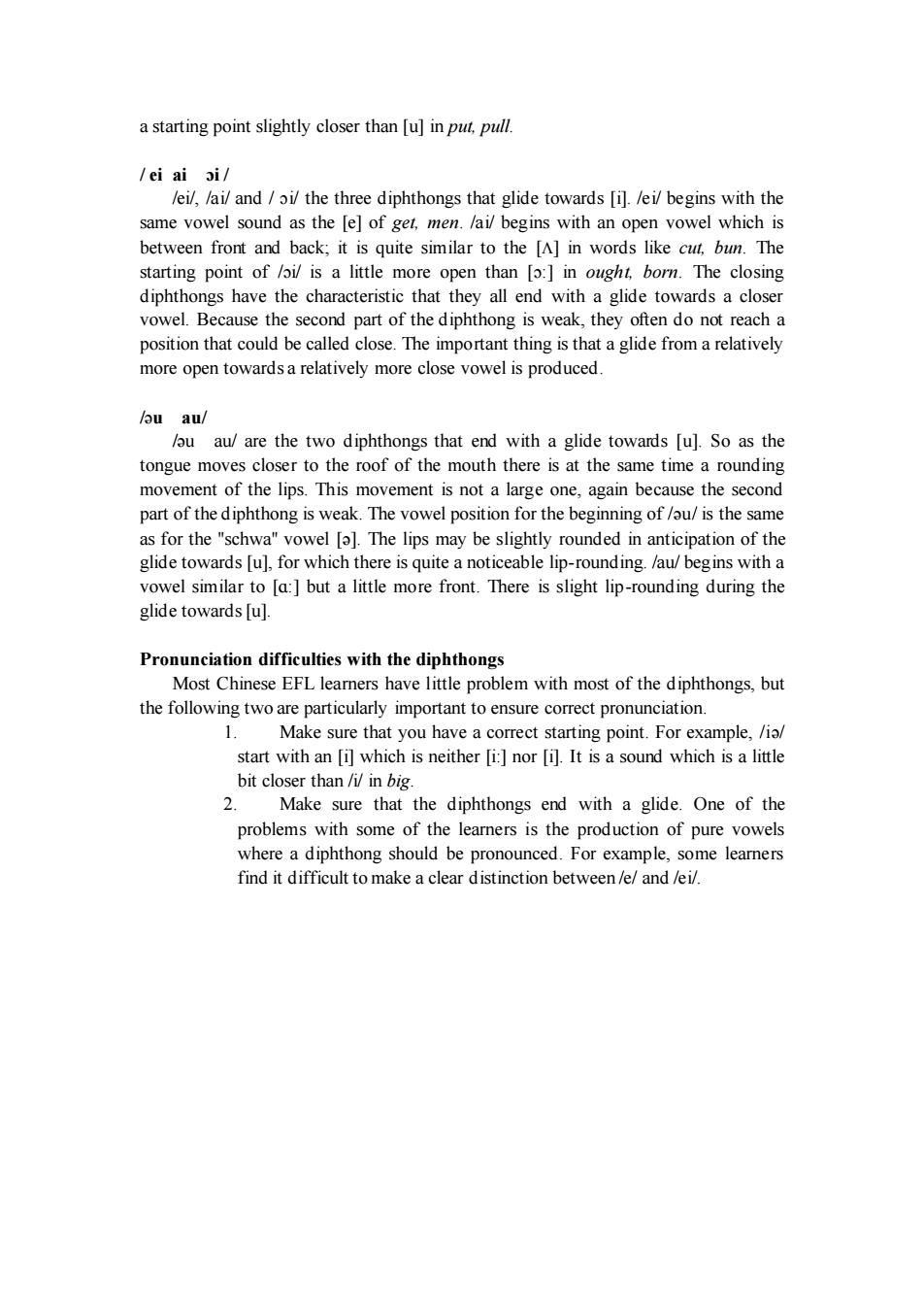正在加载图片...

a starting point slightly closer than [u]in put.pull. /ei ai si/ leil,/ai/and/i/the three diphthongs that glide towards [i]./ei/begins with the same vowel sound as the [e]of get,men./ai/begins with an open vowel which is between front and back;it is quite similar to the [A]in words like cut.bun.The [:in ought.born. The losi ongs have the characteristic open they all end with a glide towards a close vowel.Because the second part of the diphthong is weak,they often do not reach a position that could be called close.The important thing is that a glide from a relatively more open towards a relatively more close vowel is produced. /ou au/ ou au/are the two diphthongs that end with a glide towards [u].So as the tongue moves closer to the roof of the mouth there is at the same time a rounding movement of the lips.This movement is not a large one,again because the second part of the diphthong is weak.The vowel position for the beginning of/au/is the same vowel []The lips towards [u for which t may be s y round n nticipation of the ere is quite a noticeable lip-rounding.u/begins with a vowel similar to [a:]but a little more front.There is slight lip-rounding during the glide towards [u]. Pronunciation difficulties with the diphthon Most Chinese EFL leamers have litte problem with most of the diphthongs,but the following two are particularly important to ensure correct pronunciation. Make sure that you have a correct starting point.For example,/ia/ start with an [i]which is neither [i:nor [i].It is a sound which is a little bit closer than /i/in big. Make sure that the diphthongs end with a glide.One of the problems with some of the learners is the production of pure vowels where a diphthong should be pronounced.For example,some learners find it difficult to make a clear distinction between/e/and /ei/. a starting point slightly closer than [u] in put, pull. / ei ai ɔi / /ei/, /ai/ and / ɔi/ the three diphthongs that glide towards [i]. /ei/ begins with the same vowel sound as the [e] of get, men. /ai/ begins with an open vowel which is between front and back; it is quite similar to the [Λ] in words like cut, bun. The starting point of /ɔi/ is a little more open than [ɔ:] in ought, born. The closing diphthongs have the characteristic that they all end with a glide towards a closer vowel. Because the second part of the diphthong is weak, they often do not reach a position that could be called close. The important thing is that a glide from a relatively more open towards a relatively more close vowel is produced. /әu au/ /әu au/ are the two diphthongs that end with a glide towards [u]. So as the tongue moves closer to the roof of the mouth there is at the same time a rounding movement of the lips. This movement is not a large one, again because the second part of the diphthong is weak. The vowel position for the beginning of /әu/ is the same as for the "schwa" vowel [ә]. The lips may be slightly rounded in anticipation of the glide towards [u], for which there is quite a noticeable lip-rounding. /au/ begins with a vowel similar to [ɑ:] but a little more front. There is slight lip-rounding during the glide towards [u]. Pronunciation difficulties with the diphthongs Most Chinese EFL learners have little problem with most of the diphthongs, but the following two are particularly important to ensure correct pronunciation. 1. Make sure that you have a correct starting point. For example, /iә/ start with an [i] which is neither [i:] nor [i]. It is a sound which is a little bit closer than /i/ in big. 2. Make sure that the diphthongs end with a glide. One of the problems with some of the learners is the production of pure vowels where a diphthong should be pronounced. For example, some learners find it difficult to make a clear distinction between /e/ and /ei/